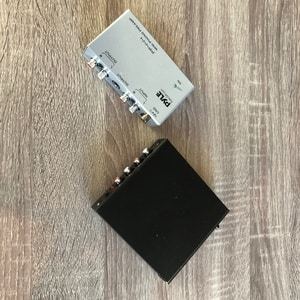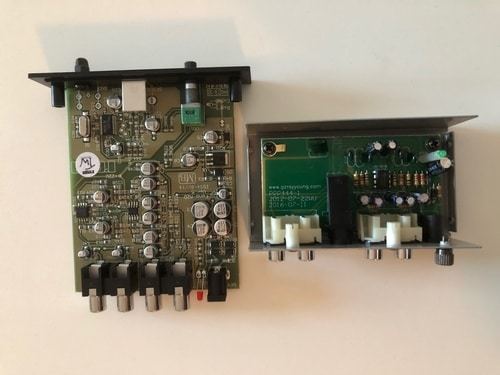I recently did a lot of reading about the importance of phono preamps.
On vinylengine.com I found a discussion thread where the original author stated that he had seven different phono preamps and couldn’t really hear any sonic difference between any of them.
While discussion threads on other forums had authors stating that the phono preamp is the most critical component in a vinyl playing stereo.
Long story short, I had to test this myself so I went to Amazon and ordered one of the cheapest preamps I could find to test against the phono preamp that is built into my $1600 Denon stereo receiver and against my $200 award-winning Rega Fono Mini A2D standalone phono preamp.
In this article, I will explain what happened. And I will give you my theory on why.
(The prices I use in this article are round numbers and indicative only. Actual prices might vary. Please click the product links below if you want to check current pricing.)
Testing Three Different Phono Preamps
I’ll start with a few words on the components that form my stereo and the three phono preamps I tested.
The turntable I use is a Rega Planar 2 with a Rega Exact cartridge upgrade. My stereo receiver is a Denon PMA-1600NE. And my speakers are the B&W 705 S2.
The whole setup costs about $4,500. Not something that gives me bragging rights in the Audiophile community, but good enough to use for the test at hand I believe.
The three phono preamps I tested are:
- Pyle Mini Phono Preamp (PP444)
- Rega Fono Mini A2D
- The one built into my Denon PMA-1600NE receiver
Note that all these preamps are solid-state. Which means that they use transistors (or op-amps) and not tubes for amplification. So we are comparing solid-state preamps at different price points in this article. And not solid-state vs. tubes. That’s for another article.

Now, I probably don’t have the most sophisticated ears in the world. Nor the most sophisticated language to describe sonic nuances. But I am an electronics engineer and I have been a home stereo geek for most of my life. So, I think I can claim that I have a some level of expertise in this field. I also have audiophile friends with $50,000 stereos and $10,000 worth of acoustic treatment. So I have a good idea of what really good sound is.
(NB! I get that the Rega Fono Mini A2D preamp might not be categorized as an expensive preamp by many hardcore audiophiles. But for many vinyl enthusiasts with normal Hi-Fi budgets, buying a phono preamp that costs $200 or so is not a given.)
Does an Expensive Phono Preamp Make a Difference?
I first started comparing the cheap Pyle Mini Phono Preamp against my trusted Rega Fono Mini A2D.
Is there a difference?
Yes.
But not a huge difference I will say.
The music sounds slightly more engaging, more detailed, richer and warmer with the Rega preamp compared to the Pyle.
But it is not night and day.
When I upgraded the cartridge on my Rega Planar 2 from the Rega Carbon to a Rega Exact, the turntable immediately sounded significantly better. And even more so after the new cartridge had broken in. That upgrade made a big difference.
The difference between the Rega and Pyle preamp is smaller.
When I compared the Pyle preamp with the one that is built-into my Denon receiver, I could not really hear a significant difference at all. Maybe the preamp in the receiver sounded slightly warmer and more engaging, but now we are really talking nuances.
So, in my ears, the Pyle and the preamp in my Denon receiver sounds basically the same. While the Rega Fono Mini A2D sounds better than the other two.
When it comes to hum and noise, none of the three preamps had any issues at all. Even with the volume cranked up high, I couldn’t notice any unwanted sounds from either of them. All quiet.
The Essence of Phono Preamps
In earlier articles on this site, I have talked about phono preamps and that they have a much “easier” job than the other components in a stereo. And that there is no obvious reason why you should spend three months of hard earned salary on a phono preamp.
Why do say that the phono preamp have an easy job?
A phono preamp doesn’t need to supply high levels of power very quickly like a quality power amplifier must do.
Phono preamps doesn’t deal with high levels of heat. Or vibrations.
Neither does a phono preamp need to transform the music from on physical form to another like a phono cartridge or a speaker.
Its only tasks are to boost a low current, low voltage and low frequency signal. And to apply quite basic tone correction (RIAA equalization).
In all honesty, the task of an electronic circuit can’t become much simpler than that.
This is why I believe that it shouldn’t need to cost a fortune to make a phono preamp with a very high-level of sonic performance.
And probably why I didn’t notice a much bigger difference between a $20 and a $200 phono preamp.

If I wrap up my test, the conclusion is that a relatively expensive phono preamp sounds better than a very cheap one, but that there isn’t a night and day difference.
They sound different enough to make it worthwhile to buy a quality preamp, but not so different that normal vinyl enthusiasts should go fully overboard and treat the phono preamp as the most critical component of the stereo.
Why Phono Preamps Sound Different
My theory is that there are two main reasons why one solid-state preamp sounds slightly better (and different) than another.
1. Impedance
The output impedance of a phono cartridge is inductive in nature while the input impedance of a phono preamp is capacitive.
The result is basically a low pass filter with one or several resonance frequencies.
The actual impedance characteristic of the cartridge and the actual impedance characteristic of the phono preamp will determine the frequency response (character) of the filter that they create.
And the frequency response of that filter might have a noticeable impact on the sound of the stereo.
A flatter and more neutral frequency response will to neutral ears sound better. Since good sound can be measured by how close it is to the original recorded music.
The match between the impedance of the phono preamp and the impedance of the cartridge will impact the character and quality of the sound.
This might be a big part of the reason why I regard my Rega Fono Mini A2D as better sounding than the Pyle preamp and the preamp that is built into my Denon receiver. The Rega preamp is probably better matched to the Rega Exact cartridge on my turntable than the two other preamps.
2. Components (quality & color)
Another main reason why a more expensive preamp sounds better than a cheap one is the quality of the electronic components used in the design.
Even though the task of a solid-state phono preamp is relatively simple, the quality of the components and design will have some level of impact on the sound quality.
Different types of amplification technology might also impact the sound of a phono preamp. A phono preamp that only uses bipolar transistors in the circuitry might sound slightly different that one that use FET transistors. And the type (and quality) of the capacitors used might impact as well.
Since a solid-state phono preamp doesn’t deal with high current, high voltages, high temperatures or high frequencies, it still shouldn’t cost a fortune to source very high-quality components. The phono preamp circuitry is relatively simple, so it is not that many critical components to source either.
Which, again, make me think that almost all the sonic potential of a solid-state phono preamp has to be maxed out long before we reach crazy amounts of money.
Different vs Better
When we look for the best and most awesome sound, one distinction we need to make is different vs. better.
When we bring home a new piece of gear that finally will make our stereo sound ultra awesome, one question we sometimes need to ask ourself is this:
Did it make my stereo sound better?
Or did it just make my stereo sound different in a way that I prefer?
A $1000 tube phono preamp might sound noticeably different than a $1000 transistor based phono preamp. Tubes have a distinct sound character. Warmer and smoother, right?
But does it sound better? Does it make the reproduced music sound closer to its identical sound?
Maybe.
Or maybe it just sounds different. It might actually make the music sound farther from its original sound. But in a way we prefer.
This brings up an important point.
Buying gear that sounds different in the right way, might take your stereo much closer to your view of perfect sound than buying gear that is super expensive and considered ultra high-end.
Conclusion
In my testing, I found that a $200 quality solid-state phono preamp sound better than a cheap $20 solid-state phono preamp.
The difference is absolutely noticeable. But not huge.
In my earlier experiments with affordable vs. more expensive phono cartridges, I found that the difference between affordable and expensive is much bigger for cartridges than for solid-state phono preamps.
My best tip for those that are passionate about vinyl sound, but can’t afford crazy expensive gear, is to buy a quality phono preamp and then to forget about it.
Save up till you can spend $200 or so on a quality phono preamp that matches your favorite cartridge well, and switch your focus and spending to upgrading other components like the turntable itself, the cartridge, the amplifier/receiver and the speakers.
Replacing a $200 solid-state phono preamp with a $2,000 solid-state phono preamp will probably not take your stereo to a completely different level.
Replacing a $200 solid-state phono preamp with a $2000 tube phono preamp might be a different scenario though. That is something I plan to test and document in future articles. I don’t think it will make my stereo sound significantly better. But it might make my stereo sound significantly different in a way I prefer. Time will show.
Related Questions
What is a phono preamp?
A phono preamp is an electronic circuit that converts a PHONO signal from a turntable cartridge to a LINE signal. The preamp can be a standalone unit, built into the turntable or built into the amplifier/receiver.
Why do we need a phono preamp?
A phono preamp is needed because it boosts the PHONO signal level to LINE level and RIAA equalizes the PHONO signal. This is only done by a phono preamp.
What happens if I skip the phono preamp?
If you skip the phono preamp, the sound will be very low in volume and the music will have way too low bass and way too high treble. A phono preamp is absolutely necessary in a vinyl playing stereo as it provides necessary RIAA correction and necessary initial gain.
What is the difference between MM and MC?
MM stands for moving magnet and MC stands for moving coil. On a MM cartridge, there is mounted a permanent magnet on the stylus cantilever. On a MC cartridge, the coils are mounted on the stylus cantilever while the magnet is fixed.
Is a phono stage the same as a preamp?
In the context of vinyl and turntables, phono stage and preamp generally means the same. Outside the context of vinyl and turntables, a preamp can mean something different than a phono stage. In a different context, a preamp can, for instance, be the preamplifier for a microphone.